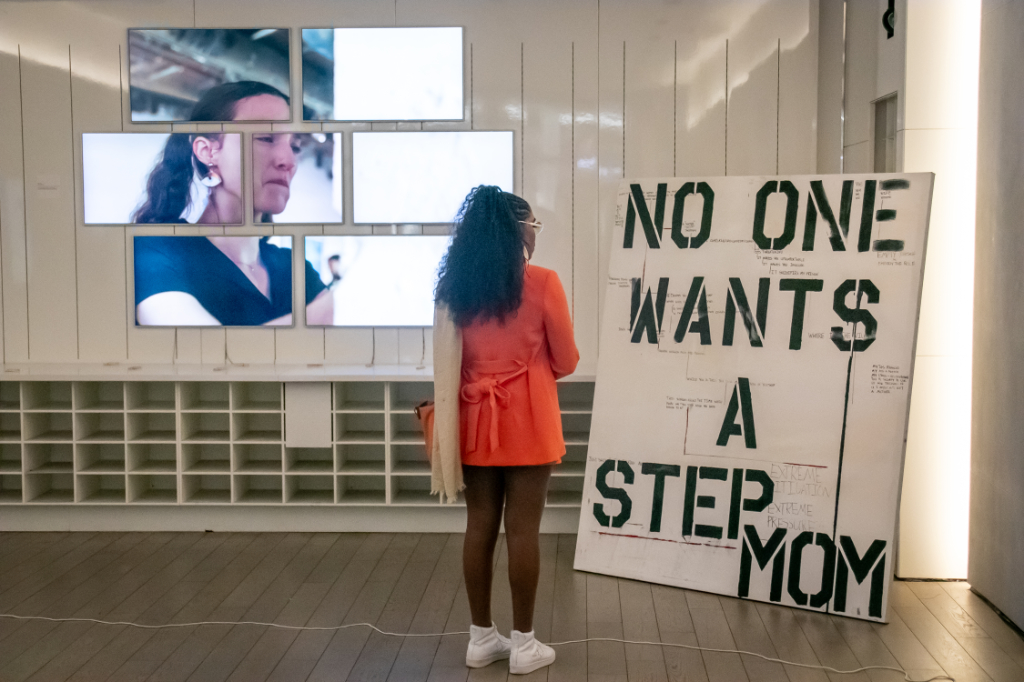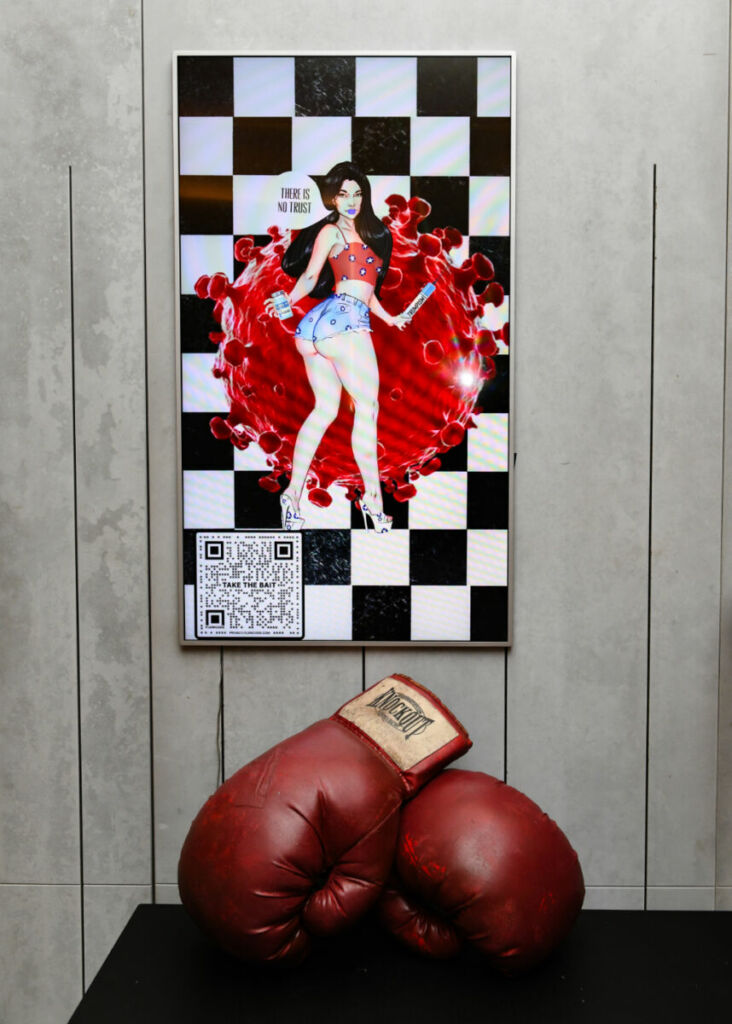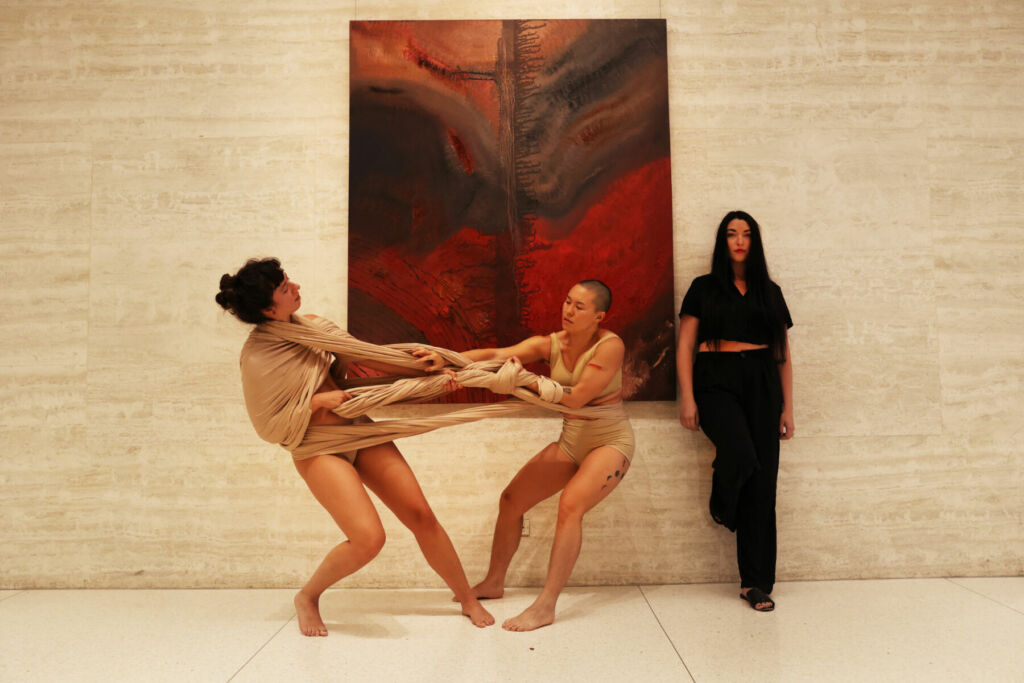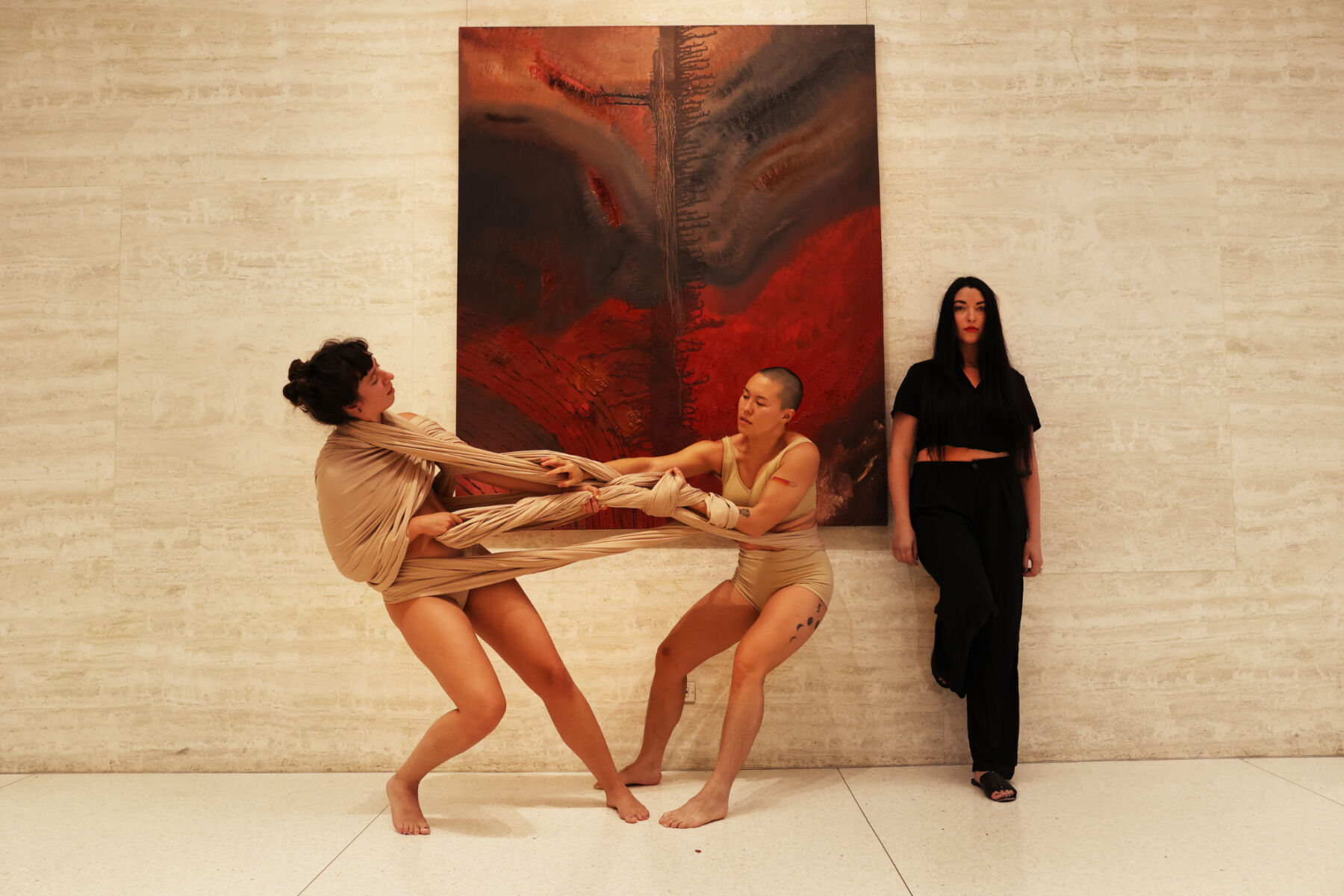Interview by Kate Hoag

Through traditional and digital art-making, multidisciplinary artist and curator Blakelee Pieroni invites viewers to ‘question their identity in relation to physicality.’ The New York-based multidisciplinary artist, with a background in dance media from Marymount Manhattan, uses choreography, painting and digital performance to examine gender equality, the roles of motherhood and contemporary identity. Pieroni’s oil painting and sound design training led her to develop a unique multimedia-based approach that challenges traditional boundaries within the art world while confronting urgent social matters.
Central to Pieroni’s current practice is her project Meta Betties, a blockchain-based digital activism initiative that combines art, fashion, performance and technology. Employing imagery visually inspired by 1940s American pin-up imagery, Meta Betties subverts historically objectified depictions of women to highlight contemporary social issues, offering a platform that both educates and facilitates action. This project allows Pieroni to create dialogues surrounding digital art as a tool for activism, where blockchain technology is harnessed to drive real-world change.
Pieroni’s exploration of societal roles and relationships is further expanded in her ongoing curated project m OTHER. This group exhibition, which later evolved into a documentary directed by Clare Louise Cheyne, delves into the complex narratives surrounding stepmothers, often overlooked in art and society. By shedding light on these stories, Pieroni invites viewers to reconsider preconceived notions about the nuclear family dynamic and identity, fostering a wider conversation on the roles of stepmothers within our communities.
In her personal practice, Pieroni creates abstract paintings, sometimes integrated with performance art and technology like augmented reality, to encourage broader conversations about the body and the role of painting today. For instance, in her performance, Labor of Materiality, presented at Art Basel Miami in 2023, Pieroni engaged the audience in a participatory action advocating for reproductive rights, ultimately blurring the lines between art and activism.
Currently, Pieroni is the artist-in-residence at The Canvas 3.0 in The Shops at the Oculus in Westfield World Trade Center, where she continues to explore tech’s intersection with movement, human behaviour and fashion with Meta Betties. Her residency includes a series of activations planned throughout 2024 that will invite more creatives to participate in monthly exhibitions focused on specific social issues. Through her work, Pieroni redefines the traditional ways of making art and exemplifies how art can serve as a powerful medium for social change in a world increasingly dominated by technology.




Your work spans multiple disciplines, from painting and choreography to digital performance art. What early influences or experiences shaped your interest in these diverse mediums?
Since I was eight years old, I felt an innate pull toward movement, not because my mother chose it but because I couldn’t imagine doing anything else. Flying through space was my first language, a form of expression I knew instinctively before I understood my body. As I grew older, the rigour of training kept me anchored in the art form. Dance, for me, became less about being seen on stage and more about the quiet conversations with the tiniest parts of myself—the challenge of technique, the pursuit of shapes that made me float and that intimacy with movement became.
I attended high school at The Salt Lake School for the Performing Arts, and this is where my artistic trajectory shifted for the better. During those formative years, I grasped the layers of production, conceptual theories, and the sacredness of performance. The freedom to create and the responsibility to execute full shows built a high respect for the craft. I went on to study dance at Marymount Manhattan College, where my curiosity expanded beyond dance into sound design, painting, and digital art. Painting, for instance, felt like choreographing to me inside each stroke and texture. You are creating the movement; unlike dance, it is not fleeting. Today, my exploration of digital performance art allows me to preserve those vibrations, that energy, on the blockchain, creating a lasting legacy that will remain long after I’m gone. There, I feel genuinely at home, where all my passions converge.
Your work integrates physical and digital elements, prompting viewers to question their identity in relation to physicality and technology. What initially drew you to explore the relationship between these two realms, and how has this exploration evolved?
The downside of being a dancer is that you’re constantly observed, objectified—trained not to show any effort and appear effortless, inside an art form created strictly for the male gaze. This experience mirrors the reality that many women-identifying bodies endure daily, blending into societal expectations of how we should present ourselves. As I studied movement alongside sociology, I found it increasingly difficult to reconcile the pressure to perform with the limitations of these traditional norms.
Discovering works from Donna Haraway, such as Simians, Cyborgs and Women / A Cyborg Manifesto and Staying with the Trouble, was an aha moment for me. The concept of the cyborg body, free from the constraints of gender and objectification, allowed me to see the possibility of a new reality—one where technology could liberate us from these outdated ideals. My work has since evolved into a critique of the human relationship with technology, nature, and societal constructs. By integrating physical bodies with digital elements, I aim to expose how we fail to acknowledge our interconnectedness while also offering a vision of what could be. The use of fetish symbols and tech serves as a reminder that we are blind to the critical relationships shaping our existence, and my work seeks to make the invisible visible.
Does your background in movement and choreography affect how you approach the representation of the human body within digital media?
Absolutely. My background in movement and choreography profoundly shapes how I represent the human body within digital media. Having worked closely with women, my narratives often unfold through immersive, long-form performance pieces emphasising repetition, slowness, and symbolism. By creating this deliberate space, I invite the audience to engage with the body’s expression on a deeper, more reflective level that resonates beyond the immediate visual.
When I ventured into NFTs, I knew I wanted to experiment with physicality on-chain. Meta Betties, my digital collectible, is a social experiment that plays with the idea of self-representation in a hyper-saturated, commodified world. I’ve crafted my avatar with intentional references to wartime 1940s pin-up girls, using Americana colours, exaggerated daisy dukes, pleaser shoes and red lipstick to draw viewers in. But beneath this overt objectification lies a deeper commentary.
In true Web3 fashion, the traits I hold, say, and use as symbolic visual cues become the real narrative. Through this work, I challenge the viewer to confront discomfort, merging erotic art, digital activism, and cyborg futurism to reflect how if we do not pay attention, history will continue to repeat itself in expected ways, especially within the digital sphere. I am begging you to wake up and stop staring at my ass by enhancing my ass and amplifying my opinions on chain.
In an age where bodies are increasingly captured and interpreted digitally, do you see this as a positive evolution, or do you have concerns about how it might alter our understanding of physicality and identity?
Whether the digital capture and interpretation of bodies is positive or negative is complex. Rather than labelling it, I see it as an inevitable evolution that brings a loss of agency for the exchange of possibilities. Technology is reshaping our relationship with physicality and identity, often diminishing individual freedom in ways we can’t fully control. Yet, it also offers new avenues for expression, particularly in movement and dance. Artists like Ania Catherine and Dejha Ti within their brand Operator, for example, have revolutionised how we perceive the body through technology, using their work to explore the tension between privacy and transparency in blockchain technology. Their pieces have forever altered the dance landscape, pushing boundaries and offering a deeper understanding of the body’s and tech’s relationship.
Through my work with Meta Betties, I often reflect on this duality. The pressure to maintain a certain image—sexy, relevant, the “it” person—continues in both physical and Web 2 spaces, sustained by the industries of sex, money, and appearance. However, in this new digital era, I sense a shift. The younger generation is beginning to prioritise intelligence and innovation over mere appearance. As our reflections become increasingly captured and commodified, I believe they will lose their power, giving way to more profound explorations of identity and presence. We want more. That is clear.
How does digital activism influence your work, and what role do you believe it plays in driving social change through art?
Digital activism is deeply woven into the fabric of my work throughout the Meta Betties franchise. Each collectible in our Art and Fashion collections aligns with critical social challenges, embodied by distinct Personas that mirror current events and cultural conflicts. These Personas are not just artistic statements but are intricately linked to real-world issues, with a portion of each sale donated to organisations that resonate with the Persona’s mission. This approach transforms each piece into a symbol of social awareness, capturing the zeitgeist while driving support for meaningful causes.
The Meta Betties project acts as a dynamic time capsule, with each collection serving as a permanent record of social progression and cultural expression. By creating vintages of socially conscious collections on the blockchain, we provide a retrospective lens through which future generations can analyse and understand past societal issues. This digital permanence offers a unique opportunity for reflection and anthropological analysis, making each collectible a testament to our collective journey toward social change.
Our commitment to digital activism extends beyond art into fashion technology with our Act 2 Earn system. This initiative integrates fashion with activism, enabling wearers to support and promote causes directly through their garments. Embedded microchips connect to advocacy tools and campaigns, allowing users to engage with and contribute to social issues while earning rewards. This fusion of fashion and activism amplifies our “Doing Well while Doing Good” mission, driving positive social impact and fostering a community dedicated to promoting justice and equality.
For your live pieces, how do you get audiences involved in your performance? Can you share a time when the audience’s involvement changed or shaped one of your pieces?
Audience involvement in my live performances is central to the essence of Meta Betties. Each piece is crafted as a visual performance and always has a call to action. For example, at Art Basel Miami last year, I used NFC chips embedded within eggs soaked in blood. I invited the audience to scan the eggs, prompting them to send a message to their legislators supporting the Women’s Protection Act for reproductive rights. This direct interaction transformed the performance into a participatory act of advocacy, merging the visceral with the political.
In another instance, during our “Take The Bait” exhibition, I integrated a live game of human chess. Each move was influenced by the number of signatures collected for different legislative bills through Meta Betties personas in the gallery. The audience engagement determines the movement and narrative of the pieces. This real-time interaction shaped the piece and deepened the audience’s connection to the cause and the artwork.
Most recently, in “Interstellar Overdrive,” I introduced an exclusive “peep show,” accessible only through joining my Allow List with a crypto wallet. Over 100 individuals joined, which was my goal because I want to see the dedication of the crypto art community inside my project. The performance featured nuns playing strip poker for peace, with poker cards representing 52 classic Meta Betties’ traits. Their clothing and messages were revealed as they bet on societal and political issues.
The use of the traits from the digital collection shows how deeply integrated they are with the themes in my performance art. This is a genuine cross-reality, crypto art project, where digital metadata transforms into neo-expressionist, physical elements emphasized within orchestrated performances. Collectors that hold traits used in performances are airdropped rewards, and community hierarchies form based on ownership and engagement. I also always provide the audience of Meta Betties performances with event tokens as a certificate of authenticity of their attendance at our shows. It is a game of erotic art, digital advocacy,
At The Canvas 3.0 in the WTC Oculus, you explore the intersection of technology, movement, and human behaviour. How does this residency influence your current work, and what can we expect to see from you during your time there?
My residency at The Canvas 3.0 in the Oculus is a dynamic exploration of technology, movement, and human behaviour. This year, I focus on showcasing the Meta Betties brand, which involves curating monthly group shows that highlight diverse artists. The space also serves as a hub for weekly Web3 meetups, where I facilitate connections, particularly for women navigating the Web3 space. Additionally, I host various nonprofits aligned with our monthly themes—like The Earth Bill for climate change awareness and Clearpath NYC’s fundraiser for homeless youth in New York.
My connected fashion line is on display in the gallery, alongside daily calls to action that reinforce our commitment to social change. Performance art is a constant presence, integrating seamlessly with the gallery’s evolving narrative. This setting allows me to merge technology with artistic expression, creating a vibrant environment where the intersection of these elements can thrive.
Ultimately, I aim to cultivate a lively, inclusive community where everyone feels at home. In this collaborative space, the ethos of “wagmi”—or “we’re all going to make it”—is central, encapsulating the spirit of mutual support and collective success that drives our work and interactions.
What projects are you currently working on?
I am preparing for the official launch of the Meta Betties collection after many months of community building. I have a group of talented, self-made women as official Meta Betties for Season 1, each contributing their unique voices and artistry. Meta Betties NFTs go beyond the digital realm, offering access to weekly short concept films that confront social and political issues with bold, provocative content.
These short films, along with the Action Center and fashion tech, further immerse the holders in their experience. The Action Center provides tools for activism and advocacy, while our fashion tech integrates the digital and physical worlds in innovative ways.
What’s your chief enemy of creativity?
The stigmas and societal pressures surrounding motherhood.
You couldn’t live without…
Dirt, espresso, shadows, and silence.






